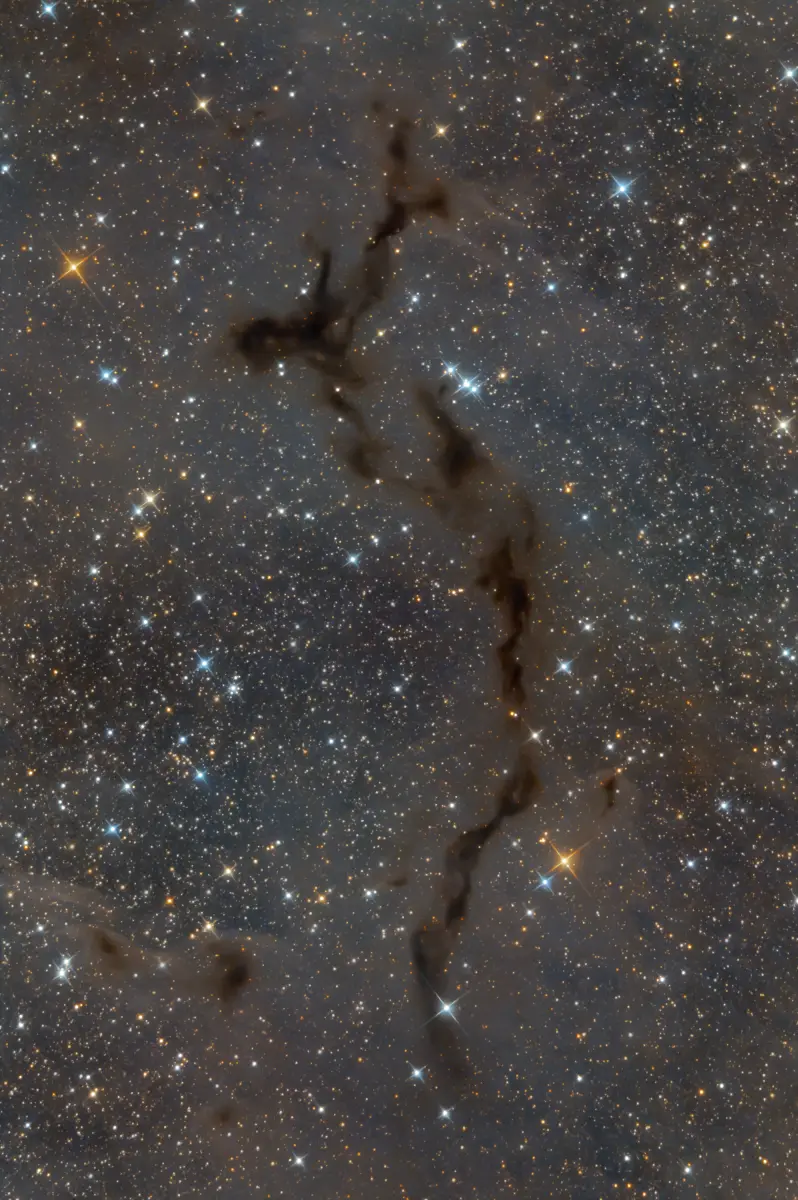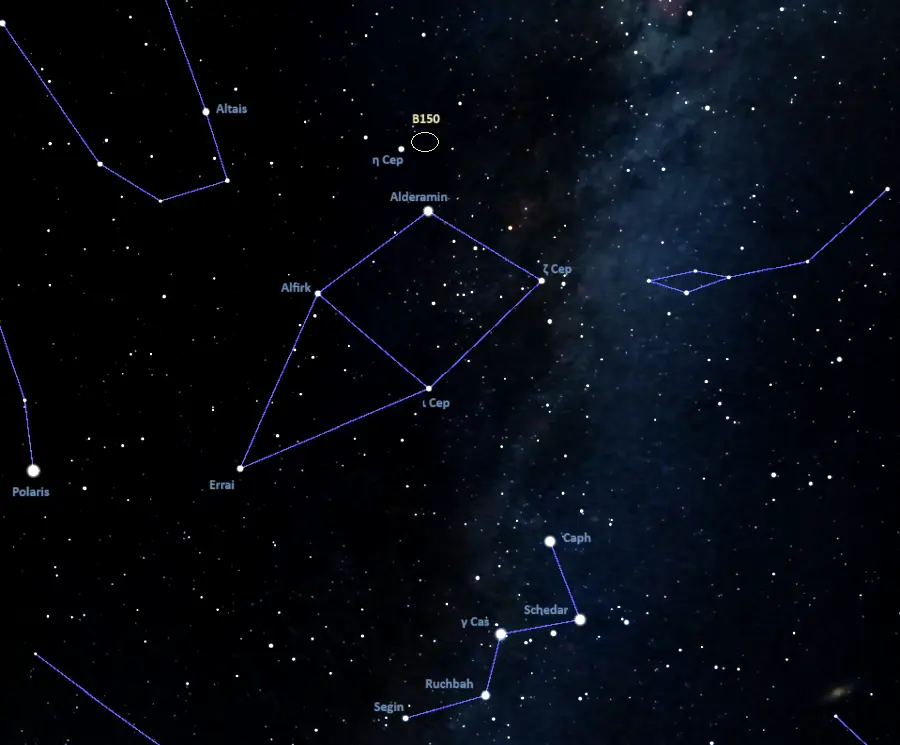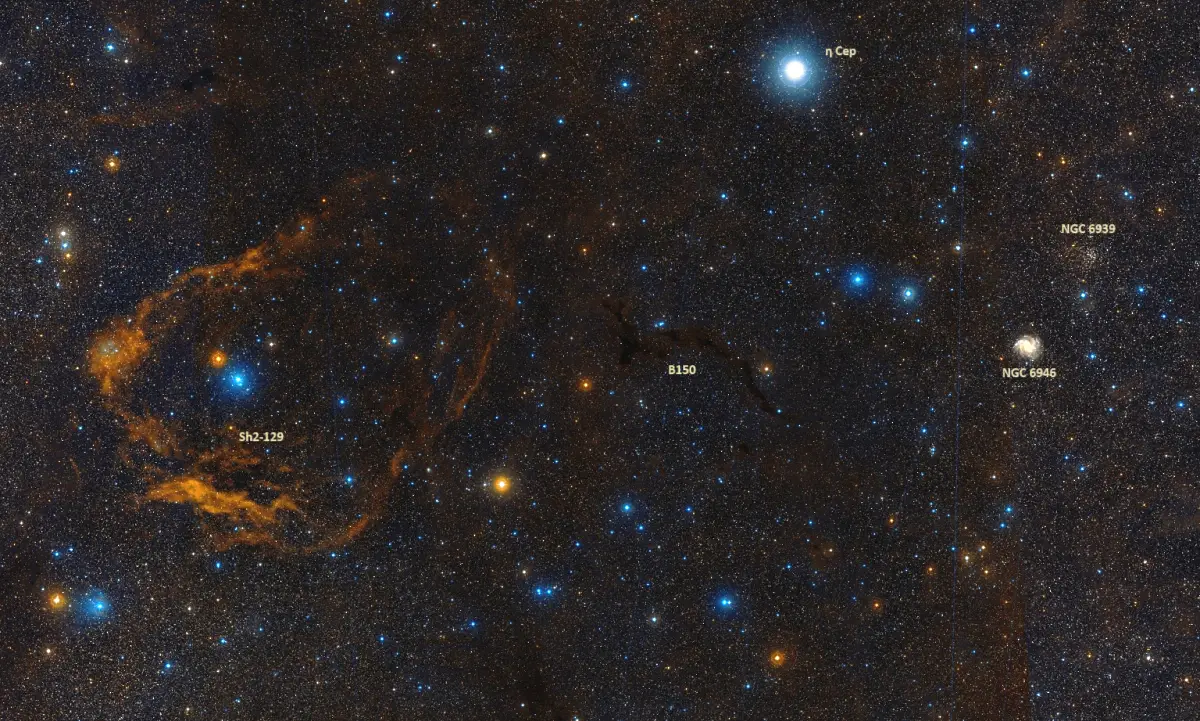The Seahorse Nebula is a large dark nebula located approximately 1,200 light-years away in the northern constellation of Cepheus (the King). It is catalogued as Barnard 150 (B150) in the Barnard Catalogue and LDN 1082 in the Lynds Catalogue of Dark Nebulae.
The Seahorse Nebula is composed of cold gas and dense interstellar dust particles coated with carbon monoxide and nitrogen. Any objects located behind the dense filamentary structure can only be observed in the radio and infrared bands.
Barnard 150 is known as the Seahorse Nebula or the Dark Seahorse Nebula because of its seahorse-like morphology. The dark absorption nebula stretches across a degree of the far northern sky in Cepheus, near the border with Cygnus (the Swan). It is a large dark filamentary molecular cloud that is dense enough to block the visible light of stars, clusters, emission and reflection nebulae, and other objects in the background.

Seahorse Nebula (Barnard 150), image credit: Simone Martina (CC BY-SA 4.0)
The dark molecular cloud of dust is part of our Milky Way galaxy. It contains three exceptionally dense dust cores. These thick regions of dark dust are in fact star formation regions. They are catalogued as LDN 1082 A, B and C. The young stellar objects (YSO) forming within them can only be observed at long infrared wavelengths.
Facts
The Seahorse Nebula was listed as the 150th object in Edward Emerson Barnard’s catalogue of dark nebulae. The American astronomer published his initial list of the “dark markings of the sky” in The Astrophysical Journal in 1919. He described B150 as a “curved dark marking, 1° long.”
E. E. Barnard studied dark nebulae and found that they were not always voids, as most astronomers believed at the time, but intervening opaque masses that blocked the light of stars behind them.
In 1962, American astronomer Beverly Turner Lynds included the Seahorse Nebula as LDN 1082 in her Catalogue of Dark Nebulae. The list was published in The Astrophysical Journal Supplement. It was based on a study of the prints obtained in the National Geographic-Palomar Observatory Sky Atlas.

Seahorse Nebula, image credit: Yann Sainty (CC BY-SA 4.0)
Location
The Seahorse Nebula appears just southeast of Eta Cephei (mag. 3.426). The orange subgiant lies southwest of the brighter Alderamin (Alpha Cephei), the luminary of the Cepheus constellation. Alderamin can be found using the stars of the more prominent Cassiopeia. A line extended from Schedar through Caph in Cassiopeia’s W leads to Cepheus’ brightest star.
The Seahorse Nebula appears in the same area of the sky as several other deep sky objects. The Fireworks Galaxy (Caldwell 12, NGC 6946) and the Ghost Bush Cluster (NGC 6939) appear west-southwest of the dark nebula, and the Elephant’s Trunk Nebula (IC 1396) appears a little further away to the east of the Seahorse.

Location of the Seahorse Nebula (Barnard 150), image: Stellarium
These objects are not related to the cosmic Seahorse. The open cluster NGC 6939 lies 3,860 light-years away and appears 2 degrees southwest of Eta Cephei. The grand design spiral galaxy NGC 6946 lies 25.2 million light years away and appears two thirds of a degree southeast of NGC 6939. It was named the Fireworks Galaxy because it is a supernova factory. It has produced 10 observed supernovae within the last century.
The Seahorse Nebula appears almost exactly halfway between NGC 6946 and the Flying Bat Nebula (Sh2-129), and the Flying Bat lies in the area between the Seahorse Nebula and the Elephant’s Trunk Nebula. The large emission nebula Sh2-129 contains the smaller Giant Squid Nebula (Ou4).
At declination 60°, the Seahorse Nebula is best seen from the northern hemisphere. It never rises above the horizon for observers south of the latitude 30° S.
The best time of the year to observe the Seahorse Nebula and other deep sky objects in Cepheus is during the month of November, when the constellation is higher above the horizon in the early evening. For northern observers, the celestial King is visible throughout the year.

Seahorse Nebula, Flying Bat Nebula, Fireworks Galaxy and Ghost Bush Cluster, ESO/Digitized Sky Survey 2 (CC BY 4.0)

The Seahorse Nebula, Flying Bat Nebula, NGC 6939 and NGC 6946, credit: José Jiménez (CC BY 2.0)
Seahorse Nebula – Barnard 150
| Constellation | Cepheus |
| Object type | Dark nebula |
| Right ascension | 20h 50m 40s |
| Declination | 60° 18′ 00″ |
| Apparent size | 1° |
| Distance | 1,200 light years (368 parsecs) |
| Names and designations | Seahorse Nebula, Dark Seahorse Nebula, Barnard 150, B150, LDN 1082, GF 9, [DB2002b] G96.98+10.07 |